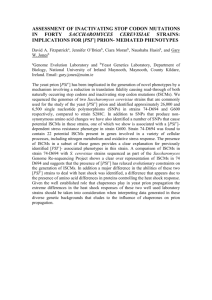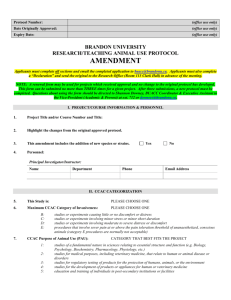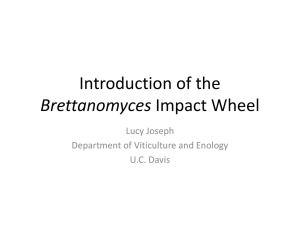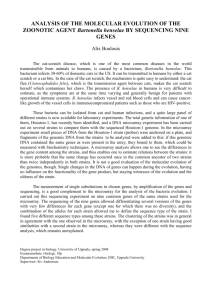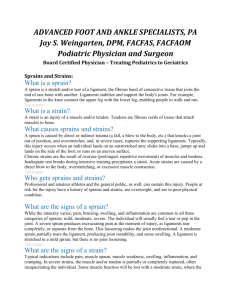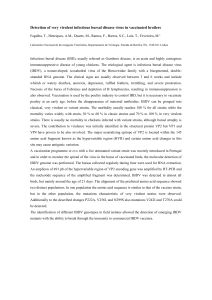Collection of Specimen, Preservation, Transportation & Registration
advertisement
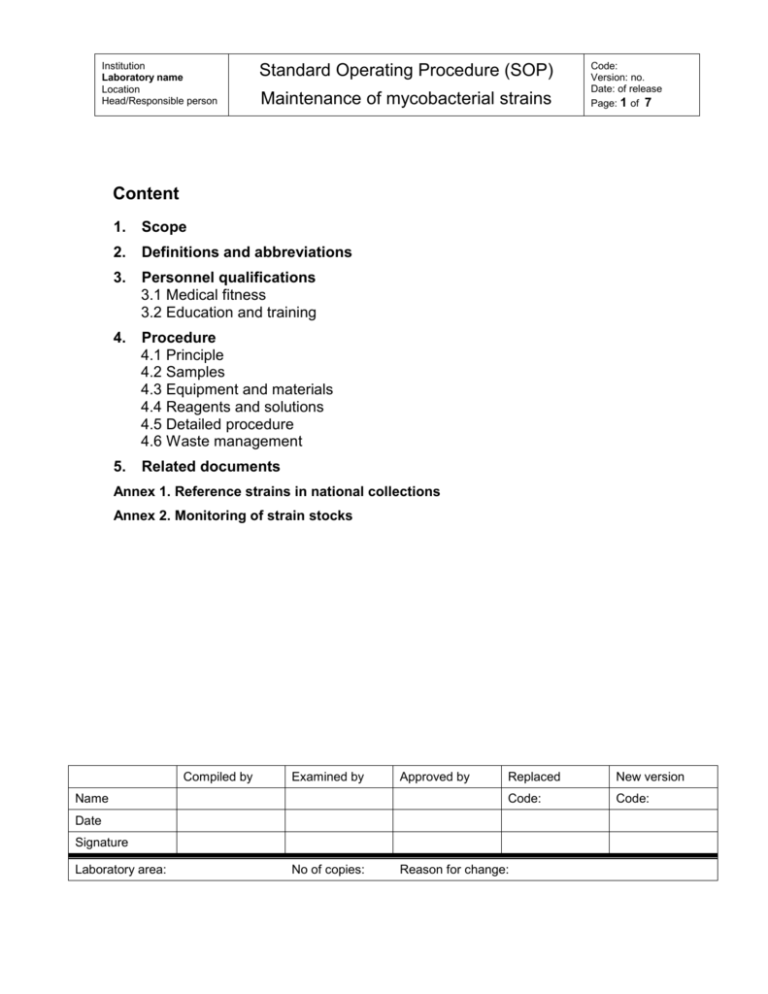
Institution Laboratory name Location Head/Responsible person Standard Operating Procedure (SOP) Maintenance of mycobacterial strains Code: Version: no. Date: of release Page: 1 of 7 Content 1. Scope 2. Definitions and abbreviations 3. Personnel qualifications 3.1 Medical fitness 3.2 Education and training 4. Procedure 4.1 Principle 4.2 Samples 4.3 Equipment and materials 4.4 Reagents and solutions 4.5 Detailed procedure 4.6 Waste management 5. Related documents Annex 1. Reference strains in national collections Annex 2. Monitoring of strain stocks Compiled by Examined by Name Approved by Replaced New version Code: Code: Date Signature Laboratory area: No of copies: Reason for change: Institution Laboratory name Location Head/Responsible person Standard Operating Procedure (SOP) Maintenance of mycobacterial strains Code: Version: no. Date: of release Page: 2 of 7 1. Scope This SOP describes optimal storage conditions for mycobacterial strains (clinical and reference strains) to ensure their viability and retention of biological characteristics over time. 2. Definitions and abbreviations –18 °C: MOTT: refers to temperatures equal to or below –18 °C mycobacteria other than tubercle bacilli 3. Personnel qualifications 3.1 Medical fitness In accordance with national laws and practices, arrangements should be made for appropriate health surveillance of TB laboratory workers: before enrolment in the TB laboratory; at regular intervals thereafter, annually or bi-annually; after any biohazard incident; at the onset of TB symptoms. Ideally, individual medical records shall be kept for up to 10 years following the end of occupational exposure. Laboratory workers should be educated about the symptoms of TB and provided with ready access to free medical care if symptoms arise. Confidential HIV counselling and testing should be offered to laboratory workers. Options for reassignment of HIV-positive or immuno-suppressed individuals away from the high-risk areas of the TB laboratory should be considered. All cases of disease or death identified in accordance with national laws and/or practice as resulting from occupational exposure to biological agents shall be notified to the competent authority. 3.2 Education and training Basic education and training must be given on the following topics: potential risks to health (symptoms of TB disease and transmission); precautions to be taken to minimize aerosol formation and prevent exposure; hygiene requirements; wearing and use of protective equipment and clothing; handling of potentially infectious materials; laboratory design, including airflow conditions; use of equipment (operation, identification of malfunctions, maintenance); prevention of incidents and steps to be taken by workers in the case of incidents (biohazard incidents, chemical, electrical and fire hazards); Institution Laboratory name Location Head/Responsible person Standard Operating Procedure (SOP) Maintenance of mycobacterial strains Code: Version: no. Date: of release Page: 3 of 7 good laboratory practice; organization of work flow; procedures for culture inoculation; viability of bacilli and strain characteristics. The training shall be: given before a staff member takes up his/her post; strictly supervised; adapted to take account of new or changed conditions; and repeated periodically, preferably every year. 4. Procedure 4.1 Principle Mycobacterial strains must be stored in conditions that preserve their viability and protect specific strain characteristics. 4.2 Samples Mycobacterial strains Reference strains (see annex 1) 4.3 Equipment and materials BSC, class I or II, annually certified Solid cultures in tubes/vials Liquid cultures in tubes/vials Cryovials with screw-caps (external screw on the tube body) Freezer at –18 °C and/or –70 °C 4.4 Reagents and solutions ADC-enriched Middlebrook 7H9 broth, prepared according to manufacturer's instructions. 10% skim milk, autoclaved at 110 °C for 10 minutes. 4.5 Detailed procedure 4.5.1 Short term storage Cultures on egg-based medium should be preferably stored at 2–8 °C and may be maintained viable for up to 1 year. These cultures may also be kept at room temperature (maximum 20 °C, in air-conditioned rooms if necessary), in the dark, but media quality may deteriorate and viability may be affected. Institution Laboratory name Location Head/Responsible person Standard Operating Procedure (SOP) Maintenance of mycobacterial strains Code: Version: no. Date: of release Page: 4 of 7 Storage of liquid cultures for more than 1 month is not recommended since media quality deteriorates rapidly and affects viability while clumping in liquids makes the determination of bacterial concentration highly unpredictable. Moreover, liquid media are more prone to contamination. 4.5.2 Long-term storage Scrape as many colonies as possible from an egg-based medium slant. Suspend colonies in a 2-ml cryovial containing 1.5 ml Middlebrook 7H9 medium or 10% skim milk. Store at –18 °C for several years or at –70 °C for decades. The viability of tubercle bacilli declines much more rapidly at –18 °C than at –70 °C: only 1% are still viable at –18 °C after 2 years compared with 100% at –70 °C. It is thus crucial to prepare the heaviest bacterial load possible in order to compensate for the loss of viability. In deciding whether they actually need a –70 °C freezer, laboratories must consider the objectives of long-term storage of mycobacterial cultures. Storage of cultures for up to 5 years after the initial isolation can be achieved at –18 °C provided that cultures (or subcultures) showed luxuriant growth and were abundant. A freezer at –70 °C may be required for national reference laboratories involved in research programmes or longterm epidemiological studies. For laboratories performing culture identification, maintenance has to be extended to MOTT species, specifically M. terrae, used for quality control of biochemical tests. Survival of MOTT is usually much better but which according to species and strain. Most bacterial species other than tubercle bacilli survive equally well at –18 °C and –70 °C (100% survival after 3 years at either temperature). 4.5.3 Long-term storage of reference cultures Reference strains for quality control of biochemical tests (M. terrae), drug susceptibility testing and medium preparation (M. tuberculosis H37Rv) must be permanently maintained in the laboratory. To avoid serial subculturing, which could lead to genetic drift and alter the phenotypic biological characteristics of strains, it is advisable to adopt the following procedure: Scrape as many colonies as possible from egg-medium slants of the reference strain. Suspend colonies in a tube containing 15 ml Middlebrook 7H9 medium or 10% skim milk (according to use in the laboratory). Dispense the suspension in 10 cryotubes, 1.5 ml per tube. Label each tube with the strain reference and date. Store at –18 °C or –70 °C. Thaw one tube and inoculate 10 tubes of egg-based medium, which will be used as the source of bacilli for quality control whenever necessary. Thaw another tube when the 10th tube source is exhausted. Monitor strain stocks (see Annex 2). 4.6 Waste management Institution Laboratory name Location Head/Responsible person Standard Operating Procedure (SOP) Maintenance of mycobacterial strains Code: Version: no. Date: of release Page: 5 of 7 Autoclave cultures – both liquid and solid – for disposal. 5. Related documents Collins C, Grange J, Yates M. Organization and practice in tuberculosis bacteriology. London, Butterworths, 1997. Kim TH, Kubica GP. Long-term preservation and storage of mycobacteria. Applied Microbiology, 1972, 24(3):311–317. Kim TH, Kubica GP. Preservation of mycobacteria:100% viability of suspensions stored at –70°C. Applied Microbiology, 1973, 25(6):956–960. Institution Laboratory name Location Head/Responsible person Standard Operating Procedure (SOP) Maintenance of mycobacterial strains Code: Version: no. Date: of release Page: 6 of 7 Annex 1. Reference strains in national collections M. tuberculosis H37Rv, ATCC 25618 M. terrae, ATCC 15755, CIP 104321, JCM 12143, DSM 43227, KCTC 9614, NCTC 10856 American Type Culture Collection (ATCC) http://www.lgcpromochem-atcc.com/common/catalog/bacteria/bacteriaIndex.cfm National Collection of Type Cultures (NCTC) http://www.ukncc.co.uk/ Deutsche Sammlung von Mikroorganismen und Zellkulturen GmbH (DSMZ) http://www.dsmz.de/ Japan Collection of Microorganisms (JCM) http://www.jcm.riken.jp/JCM/catalogue.shtml Collection Institut Pasteur (CIP) http://www.crbip.pasteur.fr/ Korean Collection of Type Cultures (KCTC) http://www.brc.re.kr/ Institution Laboratory name Location Head/Responsible person Standard Operating Procedure (SOP) Maintenance of mycobacterial strains Code: Version: no. Date: of release Page: 7 of 7 Annex 2. Monitoring of strain stocks Strain M. tuberculosis H37Rv Stock suspension in (medium) No. of tubes prepared Thawing date Date No. of tubes left 1 9 2 8 3 7 4 6 5 5 6 4 7 3 8 2 9 1 10 0 Prepare a new stock Strain M. terrae No. of tubes prepared Thawing date No. of tubes left 1 9 2 8 3 7 4 6 5 5 6 4 7 3 8 2 9 1 10 0 Prepare a new stock
